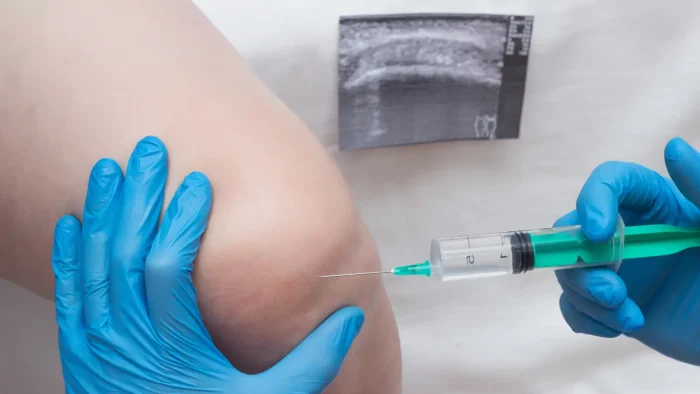
According to the Centers for Disease Control and Prevention (CDC), approximately 33 million adults in the United States suffer from osteoarthritis, with many experiencing significant joint pain that impacts their quality of life. As the population ages, effective treatment becomes increasingly important to manage symptoms and enhance daily activities.
Synvisc is a widely used treatment for knee osteoarthritis. This hyaluronic acid injection acts as a cushion and lubricant within the joint, reducing pain and improving mobility. For those who haven’t found relief through other methods, Synvisc offers a non-surgical alternative.
In this article, we will explore the Synvisc dosage guidelines, injection schedule, and what patients can expect during treatment.
Key Takeaways
- Synvisc is a hyaluronic acid-based injection used to relieve knee pain caused by osteoarthritis.
- It mimics natural joint fluid, cushioning and lubricating the knee for smoother movement.
- The standard treatment protocol includes three injections given one week apart, with pain relief lasting up to six months.
- Side effects are generally mild, including pain, swelling, and redness at the injection site.
- Serious complications, such as allergic reactions or deep vein thrombosis, are rare but require immediate medical attention.
About: Doctor Medica is your trusted supplier of top-quality dermal fillers, viscosupplements, and more for your medical practice. We offer genuine products from leading brands at the lowest prices in the market. If you’re looking to order Synvisc online for your practice, contact the Doctor Medica today.
What is Synvisc?

Synvisc is a hyaluronic acid-based injection used to relieve knee pain in individuals suffering from osteoarthritis. It mimics the natural fluid found in your joints, known as synovial fluid, for smoother joint movement. Over time, osteoarthritis causes the breakdown of this fluid, leading to joint stiffness, pain, and limited mobility.
The hyaluronic acid in Synvisc is injected directly into the knee joint, enhancing the synovial fluid’s viscosity and reducing friction between the bones. This lubrication helps cushion the joint, relieving pain and improving mobility for up to six months.
Conditions Treated with Synvisc
Synvisc injections are primarily used to treat knee osteoarthritis when other treatments, such as pain medications or physical therapy, have not been effective. It is particularly suitable for patients seeking non-surgical solutions for managing their joint pain. Synvisc is also sometimes used off-label for other joints, like the hip or shoulder.
When comparing Synvisc vs Euflexxa, both treatments offer similar relief through hyaluronic acid injections, but they differ slightly in their formulations and molecular weights. Euflexxa uses a bioengineered form of hyaluronic acid, while Synvisc is derived from chicken combs. These differences can influence patient preferences and how well each product works for individual needs.
Initial Treatment Protocol

The Synvisc treatment protocol typically involves a series of injections to provide effective and lasting relief from knee osteoarthritis pain. The standard regimen requires three injections, each containing 2 mL of hyaluronic acid, administered one week apart.
- Number of Injections Required: For full treatment, patients typically receive three injections over three weeks. This helps ensure the joint is sufficiently lubricated, maximizing the cushioning effect and pain relief.
- Timing for Follow-Up Doses: Pain relief can last up to six months after completing the initial series of injections. Patients may opt for a repeat treatment cycle after consulting their healthcare provider if the effects begin to wear off. However, follow-up doses should not be administered more frequently than every six months, as the body needs time to absorb and respond to the treatment.
- Dosage Recommendations: Each injection contains 2 mL of Synvisc. For patients with pain in both knees, the injections can be given in each knee, with a separate syringe used for each joint. The total dosage over the three-week course ensures the joint regains sufficient fluid to reduce pain and improve mobility.
Follow-Up Care and Maintenance

- Monitoring Patient Response: After the three Synvisc injections, doctors monitor how well the patient’s knee pain improves. Since the effects can last up to six months, regular follow-ups help assess progress and guide future treatment.
- Adjusting Treatment Plan if Necessary: If pain relief is insufficient after the initial treatment, the plan may need adjustments. Doctors might explore alternatives like physical therapy or different viscosupplements
- Long-term Management Considerations: Synvisc can offer relief for six months or longer. If pain returns, patients may need another round of injections after that period. Ongoing evaluations ensure long-term management without needing surgery.
Potential Side Effects and Risks
Synvisc injections are generally safe, but some patients may experience minor side effects, including:
- Pain at the Injection Site: Mild discomfort or soreness where the shot was administered.
- Swelling in the Knee: The knee area may become swollen following the injection.
- Redness and Warmth: The knee may feel warm and appear red for a short time.
- Itching Around the Knee: Some patients experience itching near the injection site.
- Bruising: Minor bruising may develop on the knee after the injection.
Serious Risks and Complications
While rare, serious risks can occur. Patients and doctors should watch for:
- Allergic Reactions: Synvisc is derived from chicken combs, so those allergic to bird proteins or egg products may experience severe reactions.
- Infection: Proper sterile techniques are critical to prevent infections at the injection site.
- Severe Pain and Swelling: Intense pain or swelling can occur and may require medical intervention if it persists.
- Deep Vein Thrombosis (DVT): Though rare, blood clots can form, potentially leading to DVT.
If you experience persistent pain, swelling, infection symptoms, or allergic reactions after the injection, seek immediate medical attention to ensure proper care.
Conclusion
Synvisc is a proven treatment for relieving knee pain caused by osteoarthritis. Administered in a series of three weekly injections, it can provide pain relief for up to six months. While side effects are uncommon, it’s essential to monitor for any reactions and follow up with your doctor if needed.
For many, Synvisc offers a valuable solution, helping to restore mobility and improve quality of life.
FAQs
1. What is Synvisc, and how does it work?
Synvisc is an injectable treatment for knee osteoarthritis that mimics the natural fluid in the joint, reducing pain and improving mobility.
2. How often do I need to take Synvisc?
Synvisc is typically given in a series of three injections, one week apart, with effects lasting up to six months.
3. Are there any side effects of Synvisc?
Common side effects include pain, swelling, redness, and itching at the injection site. Severe reactions are rare but possible.
4. Can I self-administer my Synvisc injections?
This drug requires professional medical supervision because it must be injected directly into the knee joint accurately for effective results.
References
Osteoarthritis. Centers for Disease Control and Prevention. Published January 26, 2024. https://www.cdc.gov/arthritis/osteoarthritis/index.html
RxList. (n.d.). Synvisc (Hylan G-F 20) drug information. Retrieved September 18, 2024, from https://www.rxlist.com/synvisc-drug.htm
Related Articles
Joanna Carr
VOM Filler For Lips – About VOM O
Learn about VOM Filler for lips, specifically VOM O—explore its features, benefits, and how it enhances lip volume and definition naturally.
Joanna Carr
Euflexxa vs Synvisc – How Do They Compare?
Compare Euflexxa vs Synvisc, two popular hyaluronic acid injections for knee osteoarthritis. Learn differences in ingredients, effectiveness, and side...
Joanna Carr
Synvisc Injections For Hips – Is It a Good Treatment?
Synvisc injections are commonly used to treat hip osteoarthritis (OA), offering relief by providing lubrication and cushioning to the joint.


